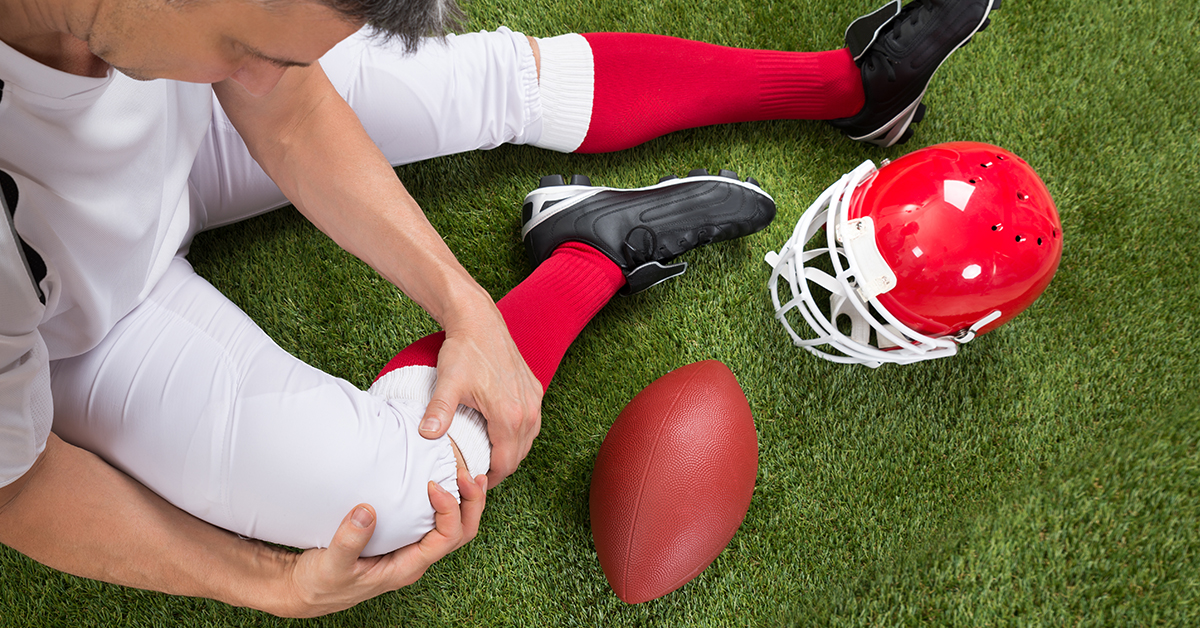
5 Common Football Injuries
We thrill at the rivalries, the strategies, and the urgency of football. It’s is one of the most popular sports in America, but it can also be one of the most dangerous. Violence is part of the sport, so injuries happen often. Below are five of the more common football injuries and how players can treat them.
Meniscus Tear
Knee injuries, particularly meniscus tears and ACL tears, are some of the most common injuries in football. The meniscus is a C-shaped piece of a cartilage in the knee that stabilizes and protects the knee. Each knee has two menisci, either of which can get torn or injured from a sudden twist, turn, or impact while the feet remain planted. In football, this can happen due to a tackle or a sudden movement. Positions that require a lot of sudden movements, like wide receiver, should take particular care to build strength, agility, and balance through a training regimen. Symptoms of a torn meniscus include pain, swelling, and stability issues. Conservative treatments like rest, ice, elevation, and compression (RICE), physical therapy and injections may provide relief. If symptoms don’t improve, minimally invasive surgery options are available that can help the player get back to their pre-injury strength.
ACL Tear
The ACL, or Anterior Crucial Ligament, is one of four primary ligaments that hold the knee together. The ACL can tear if the knee is hyperextended or forced to twist abnormally. This can happen if a player suddenly changes direction, stops, slows down while running, or lands incorrectly. Like meniscus tears, ACL tears can also be the result of direct contact, like a tackle. Symptoms of a torn ACL or meniscus vary, depending on severity. Many hear a popping noise, followed by the knee “giving.” Other symptoms might include painful swelling, impaired mobility and range of motion, and joint tenderness.
Conservative treatments should always be taken first with knee injuries. This includes RICE, as well as physical therapy. If the injury is severe, minimally invasive surgery options are available to get the player back on the field as soon as possible.
Concussion
No matter what sport is being played, concussions are a serious risk and should be avoided at all cost. Because football is a full-contact sport, players are especially at risk for this traumatic injury to the brain. Concussions occur when a sudden impact causes the brain to strike against the inside of the skull. The symptoms of a concussion vary, but can include dizziness, “seeing stars”, nausea, headache or confusion. In some cases, a player may briefly lose consciousness. Some may feel symptoms hours or days after the concussion, including memory lapses, mood swings, and sensitivity to light or noise. Rest from all activity should be taken as soon as possible. A CT scan may be taken to gauge the severity of the concussion, and overnight observation should be maintained. If symptoms get worse, it could indicate potentially fatal swelling or bleeding. While the brain heals, players should wait to return to any activities where a second concussion could be sustained. This could cause Second Impact Syndrome, a potentially fatal condition in which the brain swells rapidly due to a second impact during the healing process. Players can help avoid concussions by keeping their heads up and not leading with their helmets. NFL and NCAA bans on head-to-head collisions were passed in an effort to cut down on the high incidence of concussions in football.
Shoulder Dislocations
If the head of the bone in the upper arm, or humerus, slips out of the glenoid socket, it is called a shoulder dislocation. In football, this can happen if a player is tackled while throwing the ball or tackled while carrying the ball while lowering the shoulder for protection. It can also happen if a player falls incorrectly on an outstretched arm. Symptoms of shoulder dislocation include pain, weakness, mobility issues, bruising, numbness and swelling. The arm may also appear to hang incorrectly on the shoulder. Treatment involves manually returning the humerus to the glenoid in a process called reduction. An X-ray or other tests may be needed to ensure no other damage has occurred in the shoulder. If other tendons, nerves, or ligaments appear to be damaged, surgery may be needed.
Muscle Strain
Muscle strain is what occurs when a muscle is pushed past its limit. Severe muscle strain can cause the muscle to pull, or worst case, can cause a muscle tear. Muscle strains are graded according to severity, from a mild and relatively quick healing grade 1 strain to a grade 3 strain, which is a complete muscle tear. Strain can occur if the muscle is suddenly presented with a heavy load or is stretched beyond its normal ability. If muscles are tight but not warmed up or are not conditioned well, strain or tearing is a risk. Symptoms of a muscle tear include pain at rest or when the muscle is used, weakness or inability to use the muscle.
Athletes are particularly prone to muscle strain because their muscles are usually tight. Unless a strict stretching regimen is followed, a player may find himself off the field, nursing a strained hamstring or calf. Treatment depends on the severity of the injury. If conservative treatment like rest, ice, compression, and elevation (RICE) and a set period of physical therapy do not treat the problem, your doctor may consider surgery, depending on the injury’s severity. The procedure performed depends on the location and severity of the tear. Regardless of what procedure is performed, rehabilitation will require physical therapy and dedication to stretching and strengthening exercises to heal the injury properly and to avoid another strain in the future.
